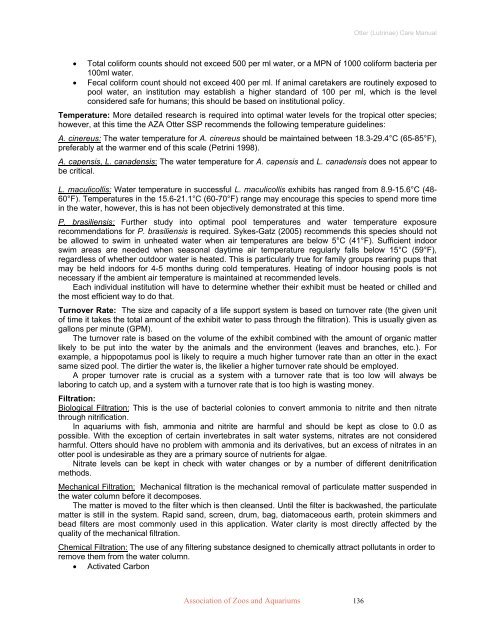Otter (Lutrinae) Care Manual - Association of Zoos and Aquariums
Otter (Lutrinae) Care Manual - Association of Zoos and Aquariums
Otter (Lutrinae) Care Manual - Association of Zoos and Aquariums
Create successful ePaper yourself
Turn your PDF publications into a flip-book with our unique Google optimized e-Paper software.
<strong>Association</strong> <strong>of</strong> <strong>Zoos</strong> <strong>and</strong> <strong>Aquariums</strong> 136<br />
<strong>Otter</strong> (<strong>Lutrinae</strong>) <strong>Care</strong> <strong>Manual</strong><br />
• Total coliform counts should not exceed 500 per ml water, or a MPN <strong>of</strong> 1000 coliform bacteria per<br />
100ml water.<br />
• Fecal coliform count should not exceed 400 per ml. If animal caretakers are routinely exposed to<br />
pool water, an institution may establish a higher st<strong>and</strong>ard <strong>of</strong> 100 per ml, which is the level<br />
considered safe for humans; this should be based on institutional policy.<br />
Temperature: More detailed research is required into optimal water levels for the tropical otter species;<br />
however, at this time the AZA <strong>Otter</strong> SSP recommends the following temperature guidelines:<br />
A. cinereus: The water temperature for A. cinereus should be maintained between 18.3-29.4°C (65-85°F),<br />
preferably at the warmer end <strong>of</strong> this scale (Petrini 1998).<br />
A. capensis, L. canadensis: The water temperature for A. capensis <strong>and</strong> L. canadensis does not appear to<br />
be critical.<br />
L. maculicollis: Water temperature in successful L. maculicollis exhibits has ranged from 8.9-15.6°C (48-<br />
60°F). Temperatures in the 15.6-21.1°C (60-70°F) range may encourage this species to spend more time<br />
in the water, however, this is has not been objectively demonstrated at this time.<br />
P. brasiliensis: Further study into optimal pool temperatures <strong>and</strong> water temperature exposure<br />
recommendations for P. brasiliensis is required. Sykes-Gatz (2005) recommends this species should not<br />
be allowed to swim in unheated water when air temperatures are below 5°C (41°F). Sufficient indoor<br />
swim areas are needed when seasonal daytime air temperature regularly falls below 15°C (59°F),<br />
regardless <strong>of</strong> whether outdoor water is heated. This is particularly true for family groups rearing pups that<br />
may be held indoors for 4-5 months during cold temperatures. Heating <strong>of</strong> indoor housing pools is not<br />
necessary if the ambient air temperature is maintained at recommended levels.<br />
Each individual institution will have to determine whether their exhibit must be heated or chilled <strong>and</strong><br />
the most efficient way to do that.<br />
Turnover Rate: The size <strong>and</strong> capacity <strong>of</strong> a life support system is based on turnover rate (the given unit<br />
<strong>of</strong> time it takes the total amount <strong>of</strong> the exhibit water to pass through the filtration). This is usually given as<br />
gallons per minute (GPM).<br />
The turnover rate is based on the volume <strong>of</strong> the exhibit combined with the amount <strong>of</strong> organic matter<br />
likely to be put into the water by the animals <strong>and</strong> the environment (leaves <strong>and</strong> branches, etc.). For<br />
example, a hippopotamus pool is likely to require a much higher turnover rate than an otter in the exact<br />
same sized pool. The dirtier the water is, the likelier a higher turnover rate should be employed.<br />
A proper turnover rate is crucial as a system with a turnover rate that is too low will always be<br />
laboring to catch up, <strong>and</strong> a system with a turnover rate that is too high is wasting money.<br />
Filtration:<br />
Biological Filtration: This is the use <strong>of</strong> bacterial colonies to convert ammonia to nitrite <strong>and</strong> then nitrate<br />
through nitrification.<br />
In aquariums with fish, ammonia <strong>and</strong> nitrite are harmful <strong>and</strong> should be kept as close to 0.0 as<br />
possible. With the exception <strong>of</strong> certain invertebrates in salt water systems, nitrates are not considered<br />
harmful. <strong>Otter</strong>s should have no problem with ammonia <strong>and</strong> its derivatives, but an excess <strong>of</strong> nitrates in an<br />
otter pool is undesirable as they are a primary source <strong>of</strong> nutrients for algae.<br />
Nitrate levels can be kept in check with water changes or by a number <strong>of</strong> different denitrification<br />
methods.<br />
Mechanical Filtration: Mechanical filtration is the mechanical removal <strong>of</strong> particulate matter suspended in<br />
the water column before it decomposes.<br />
The matter is moved to the filter which is then cleansed. Until the filter is backwashed, the particulate<br />
matter is still in the system. Rapid s<strong>and</strong>, screen, drum, bag, diatomaceous earth, protein skimmers <strong>and</strong><br />
bead filters are most commonly used in this application. Water clarity is most directly affected by the<br />
quality <strong>of</strong> the mechanical filtration.<br />
Chemical Filtration: The use <strong>of</strong> any filtering substance designed to chemically attract pollutants in order to<br />
remove them from the water column.<br />
• Activated Carbon









